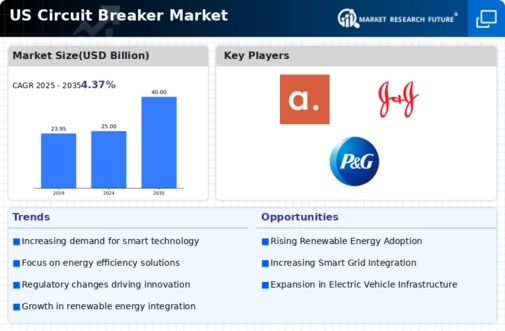Growing Demand for Energy Efficiency
Energy efficiency is a critical driver in the circuit breaker market, as both residential and commercial sectors seek to reduce energy consumption and costs. The increasing focus on energy-efficient solutions is prompting manufacturers to develop circuit breakers that minimize energy losses. In the US, energy efficiency programs are gaining traction, with many states implementing regulations that encourage the use of energy-efficient electrical equipment. This trend is likely to propel the circuit breaker market, as energy-efficient products are projected to account for over 30% of the total market share by 2026. The emphasis on sustainability and cost savings is pushing consumers and businesses to invest in advanced circuit breaker technologies that align with energy efficiency goals.
Increased Focus on Safety and Reliability
Safety and reliability are paramount in the circuit breaker market, particularly as electrical systems become more complex. The rising incidence of electrical fires and failures has heightened awareness regarding the importance of circuit breakers in preventing such hazards. Regulatory bodies are enforcing stricter safety standards, compelling manufacturers to innovate and enhance the reliability of their products. The circuit breaker market is likely to benefit from this increased focus, as consumers prioritize safety features in their purchasing decisions. It is estimated that products meeting enhanced safety standards could capture a larger market share, potentially increasing by 20% in the next few years. This trend underscores the critical role of circuit breakers in ensuring safe electrical operations.
Infrastructure Development and Urbanization
The ongoing infrastructure development and urbanization in the US significantly impact the circuit breaker market. As cities expand and new construction projects emerge, the demand for reliable electrical systems increases. Circuit breakers play a crucial role in ensuring the safety and reliability of electrical installations in residential, commercial, and industrial buildings. The US government has allocated substantial funding for infrastructure projects, which is expected to boost the circuit breaker market. Reports suggest that the market could grow by approximately 10% annually as new buildings and renovations require updated electrical systems. This trend highlights the importance of circuit breakers in supporting the growing infrastructure needs of urban areas.
Rising Adoption of Renewable Energy Sources
The shift towards renewable energy sources is reshaping the circuit breaker market, as more consumers and businesses integrate solar, wind, and other renewable technologies into their energy systems. Circuit breakers are essential for managing the complexities associated with these energy sources, ensuring safe and efficient operation. The US government is promoting renewable energy initiatives, which is likely to drive demand for circuit breakers designed specifically for renewable applications. Market analysts predict that the segment of circuit breakers catering to renewable energy could grow by over 25% in the coming years. This trend indicates a significant opportunity for manufacturers to innovate and develop products that align with the growing emphasis on sustainable energy solutions.
Technological Advancements in Circuit Breakers
The circuit breaker market is experiencing a notable transformation due to rapid technological advancements. Innovations such as digital circuit breakers and smart grid technologies are enhancing the functionality and efficiency of circuit breakers. These advancements allow for real-time monitoring and control, which is becoming increasingly essential in modern electrical systems. The integration of IoT (Internet of Things) in circuit breakers is expected to drive market growth, as it enables predictive maintenance and reduces downtime. According to industry estimates, the adoption of smart technologies could increase the market size by approximately 15% over the next five years. This trend indicates a shift towards more intelligent and automated solutions in the circuit breaker market, catering to the evolving needs of consumers and industries alike.














Leave a Comment